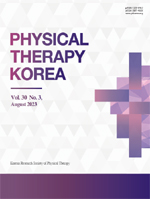Effects of a Posture Correction Feedback System on Upper Body Posture, Muscle Activity, and Fatigue During Computer Typing
Effects of a Posture Correction Feedback System on Upper Body Posture, Muscle Activity, and Fatigue During Computer Typing
- 한국전문물리치료학회
- 한국전문물리치료학회지
- 제30권 제3호
-
2023.08221 - 229 (9 pages)
-
DOI : 10.12674/ptk.2023.30.3.221
- 15

Background: In modern society, the use of computers accounts for a large proportion of our daily lives. Although substantial research is being actively conducted on musculoskeletal diseases resulting from computer use, there has been a recent surge in interest in improving the working environment for prevention. Objects: This study aimed to examine the effects of posture correction feedback (PCF) on changes in neck posture and muscle activation during computer typing. Methods: The participants performed a computer typing task in two sessions, each lasting 16 minutes. The participant’s dominant side was photographed and analyzed using ImageJ software to verify neck posture. Surface electromyography (EMG) was used to confirm the par-ticipant’s cervical erector spinae (CES) and upper trapezius muscle activities. The EMG signal was analyzed using the percentage of reference voluntary contraction and amplitude prob-ability distribution function (APDF). In the second session, visual and auditory feedback for posture correction was provided if the neck was flexed by more than 15° in the initial position during computer typing. A 20-minute rest period was provided between the two sessions. Results: The neck angle (p = 0.014), CES muscle activity (p = 0.008), and APDF (p = 0.015) showed significant differences depending on the presence of the PCF. Furthermore, signifi-cant differences were observed regarding the CES muscle activity (p = 0.001) and APDF (p = 0.002) over time. Conclusion: Our study showed that the feedback system can correct poor posture and re-duces unnecessary muscle activation during computer work. The improved neck posture and reduced CES muscle activity observed in this study suggest that neck pain can be prevented. Based on these results, we suggest that the PCF system can be used to prevent neck pain.
INTRODUCTION
MATERIALS AND METHODS
RESULTS
DISCUSSION
CONCLUSIONS
FUNDING
ACKNOWLEDGEMENTS
CONFLICTS OF INTEREST
AUTHOR CONTRIBUTION
ORCID
REFERENCES
(0)
(0)